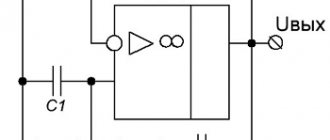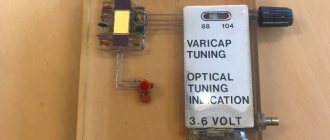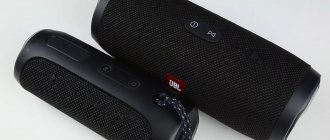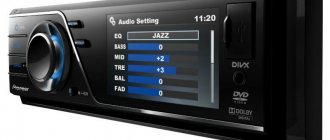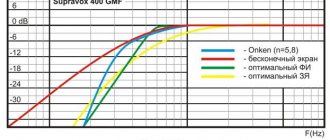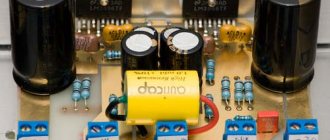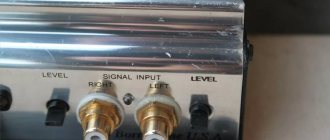Audio frequency generator
What is a sound generator and what is it used for? So, let's first define the meaning of the word “generator”. Generator - from lat. generator - manufacturer. That is, to explain in everyday language, a generator is a device that produces something. Well, what is sound? Sound is vibrations that our ears can detect. Someone farted, someone hiccupped, someone sent someone - all these are sound waves that our ears hear. A normal person can hear vibrations in the frequency range from 16 Hz to 20 Kilohertz. Sound up to 16 Hertz is called infrasound , and sound over 20,000 Hertz is called ultrasound .
From all of the above, we can conclude that a sound generator is a device that emits some kind of sound. Everything is elementary and simple. Why don’t we assemble it? Scheme to the studio!
As we can see, my circuit consists of:
- capacitor with a capacity of 47 nanoFarads
- 20 Kilohm resistor
- transistors KT315G and KT361G, maybe with other letters or even some other low-power ones
- small dynamic head
- a button, but you can do it without it.
On the breadboard it all looks something like this:
And here are the transistors:
On the left is KT361G, on the right is KT315G. For KT361 the letter is located in the middle of the case, and for 315 it is on the left.
You should find out what a solid state relay is.
These transistors are complementary pairs to each other.
And here is the video:
The frequency of the sound can be changed by changing the value of the resistor or capacitor. Also, the frequency increases if the supply voltage is increased. At 1.5 Volts the frequency will be lower than at 5 Volts. In my video the voltage is set to 5 Volts.
Cool article - the Peltier element.
Do you know what else is funny? Girls have a much greater range of perception of sound waves than boys. For example, guys can hear up to 20 Kilohertz, and girls can even hear up to 22 Kilohertz. This sound is so squeaky that it really gets on your nerves. What do I want to say by this?)) Yes, yes, why don’t we choose resistor or capacitor values such that girls hear this sound, but boys don’t? Just imagine, you are sitting in class, turning on your organ and looking at the dissatisfied faces of your classmates. In order to set up the device, we will of course need a girl to help us hear this sound. Not all girls also perceive this high-frequency sound. But the really funny thing is that it’s impossible to find out where the sound is coming from))). Only if anything, I didn’t tell you that).
Find out what lm317t is.
1 kHz sound generator
Rice. 2 - Sound generator at 1 kHz
As can be seen from the diagram (Fig. 2), the generator is an amplification stage covered by positive feedback. The generation frequency is determined by the values of capacitors C1-C3 and resistors R1-R3. At the indicated ratings, the generation frequency is approximately 1 kHz. The transistor used in this circuit must have a sufficiently high static base current transfer coefficient - at least 100-150.
The sinusoidal voltage is removed from the collector load of the transistor. To reduce the output resistance of the generator, an emitter follower on transistor VT2 is used. This stage matches the low load impedance with the fairly high output impedance of the generator. Using variable resistor R7, you can set the level of the generator output signal. The generator can be powered from a Krona battery or from a network source.
In the generator, in addition to those indicated, you can use transistors of the KT3102 type, and when changing the polarity of the power source - KT3107, KT361G. Particular attention should be paid to the choice of the type of capacitors in the phase-shifting circuit - here it is better to use film (type K73.) capacitors with a low deviation from the nominal value (no more than 5%).
Electrical circuit and operating principle of the generator
SOUND GENERATOR
Purpose of the device
The GZM sound generator (educational) is designed to produce sinusoidal electrical oscillations of sound frequency when demonstrating various experiments in physics and electrical engineering in high school. The generator can be used as a low frequency amplifier.
Technical specifications
1. The range of generated frequencies from 20 to 20,000 Hz is covered by three subranges:
subrange (x1) from 20 to 200 Hz , subrange (x10) from 200 to 2000 Hz, subrange (x100) from 2000 to 20,000 Hz.
2. Generator frequency error is no more than ±(0.1f +1) Hz.
3. Rated output power 2W.
4.
The maximum output power should be no more than 4 W.
5. Nonlinear distortion in the frequency range 60 ¸ 15,000 Hz no more than 5% at rated output power at a load of 600 Ohms.
6. The generator output is designed for 5 ohm, 600 ohm and 5000 ohm loads.
7. The unevenness of the frequency response of the generator relative to the frequency of 400 Hz with a matched load of 600 Ohms does not exceed ±3 dB.
8. Output voltage is adjustable smoothly.
9. The device is powered from an alternating current network with a frequency of 50 Hz and a voltage of 127 or 220 V.
10. The power consumed by the device from the network does not exceed 70 W.
P. Permissible duration of continuous operation of the device is no more than 2 hours.
12. Normal operating conditions of the device: temperature from +10 to +30 C and relative humidity 70%.
13. Dimensions of the device - 330x240x230 mm.
14. The weight of the device is no more than 15 kg.
Contents of delivery
2. Power hole assembly - 1"
3. Quick-release insert 0 6.3X32 1 A—1"
4. Operating manual - 1 copy.
Electrical circuit and operating principle of the generator
The GZM generator is assembled according to the circuit diagram shown in Fig. I. (Specification of circuit parts is given in Table 1).
From the block diagram (Fig. 2) it can be seen that the GZM generator consists of the following main parts:
The master oscillator generates sinusoidal oscillations of a strictly defined frequency. The master oscillator has a device for adjusting the oscillation frequency. These oscillations are fed to an amplifier, at the input of which there is a device for controlling the gain.
A load of 5 Ohms, 600 Ohms or 5000 Ohms is connected to the amplifier output.
In ULF mode, the master oscillator is used as a pre-amplifier.
The power supply is used to obtain direct and alternating voltages that power the device circuit.
Date added: 2016-06-29; ; ORDER A WORK WRITING
Source
Built-in editors
All low and high frequency signal generators are very easy to set up. They have several four-position controls that allow you to adjust the maximum frequency value. The transition time to steady state in most models is no more than 3 ms. Such a short time can be achieved through the use of microcontrollers.
Microcontrollers are mounted on the main board; in some designs they are removable - literally with one movement you can install a new element. In designs with a built-in editor, limiters are not installed. After the selectors, converters are located according to the diagram. Sometimes you can find synthesizers in the circuits. The maximum frequency of the generated signal can be 2000 kHz, the total error is no more than 2%.
Device diagram
Initially, a pocket alarm circuit was used, but with a little modification it turned out to be an excellent sound generator.
The cable is not needed - we don’t install it. The terminals for connecting the telegraph key are connected where the switch was located (in the design, the switch is located in the battery compartment). A multivibrator is assembled on transistors VT1, VT2. When the key (telegraph) is closed, the circuit closes and a signal is heard (since there is no loop). The elements are mounted on fiberglass laminate 1-1.5 mm.
Transistors used here are MP41 (you can use MP25, MP42, MP40 or more modern ones of a similar structure). MLT type resistors. Ceramic capacitor K10.
The speaker was used from a computer board, but you can use any other one with a resistance of 50-200 Ohms. Absolutely any switches will do.
The power source is a galvanic cell (AA) 1.5 V. Batteries made of two or three cells are suitable, since the volume of the signal depends on this.
The frequency is selected using a capacitor. Current consumption: 1-2 µA (standby) and 20 µA (working).
The body of the sound generator for telegraph operators is plastic.
The finished design is shown in the figure. The author is not specified.
Source
High frequency designs
The internal resistance of the high-frequency signal generator is about 50 Ohms. At the same time, the device is capable of delivering greater power. High-frequency designs have a bandwidth of about 2 GHz. The circuit uses permanent capacitors with a capacity of over 7 pF. This allows you to maintain the maximum current in the circuit up to 3 A. Distortion is at the level of 1%.
In high-frequency oscillators, only operational amplifiers are used. Signal limiters are installed at the beginning and end of the circuit. Microcontrollers from the PPK211 series and a six-channel selector are used for operation. Using the controls, you can set the frequency of the output signal - the minimum value is 90 Hz.
Homemade devices
You can make a signal generator with your own hands from available materials. The main part of any generator is the selector. In any design it is designed for several channels. Standard designs use no more than two microcircuits. This is enough to implement the simplest devices. Microcircuits from the KN148 series are ideal for making generators. As for converters, only analog ones are used.
In some cases, it is possible to use a personal computer as a signal generator. You can make a small adapter with your own hands - it is installed at the output of the sound card. The signal is taken from the output and used for testing equipment. A program is installed on the PC that will control the sound card. The disadvantage of this design is that the frequency range is too narrow, so it cannot be used when testing some devices.
Arbitrary pulse generator
These devices have one feature - they have a very small error. The design also provides for fine adjustment of the output signal - a six-channel selector is used for this. The minimum frequency produced by the generator is 70 Hz. Positive impulses are perceived by such generators. The circuit uses capacitors with a capacity of at least 20 pF. The device output resistance is no more than 5 ohms.
All arbitrary waveform generators differ in their timing parameters. This happens due to the type of connector installed. Because of this, the signal rise can occur in 15-40 ns. Depending on the generator model, it can have two types of modes - logarithmic and linear. Using the appropriate switches, they can be changed, which will entail amplitude correction. The total frequency error is no more than 3%.
Details
All capacitors must have a voltage of at least 16V. The H1 incandescent lamp is miniature, with a voltage of 13.5V and a current of 0.068 A. You can also use another lamp with a voltage of no less than 12V and no more than 30V and a current of no more than 0.1 A.
Power transformer T1 is used ready-made, from a network adapter with an output voltage of 12V. It has an alternating voltage on the secondary winding of about 9V. In principle, any transformer with an output voltage of about 8-10V and an output current of at least 0.1 A is suitable.
How does a mixed signal generator work?
The principle of operation of the mixed pulse generator is aimed at accelerating the formation of signals and reproducing them with maximum accuracy. The front panel of the device is equipped with controls for monitoring the most important and frequently changed parameters. Less popular and rarely used functions can be found in the menu on the main screen.
The level control sets the amplitude of movement of the output signal. Amplitude and offset can be adjusted without entering a multi-level menu system.
A separate control also allows you to change the sampling rate by changing the periodicity of the output signal. However, this customizer will not be able to change the form of the latter. This function is only available in the menu on the main editing screen. The shape is selected using the touch panel or mouse. The user opens the desired page and simply fills out the form using the numeric keypad or rotary knob.


